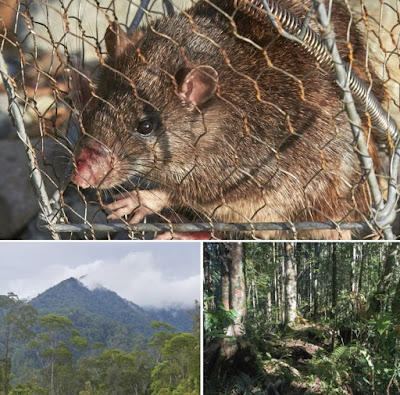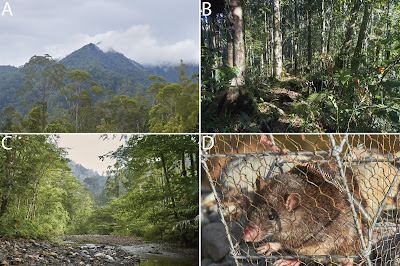[Most Recent Entries] [Calendar View]
Friday, April 6th, 2018
| Time | Event | ||||
| 12:19a | [Mammalogy • 2018] Halmaheramys wallacei • A New Species of Halmaheramys (Rodentia: Muridae) from Bisa and Obi Islands (North Maluku Province, Indonesia)
Abstract We describe a new species of murine rodent from a skull collected on Bisa Island and 3 specimens from Obi Island, North Maluku Province, Indonesia. Molecular and morphological data indicate a close relationship with Halmaheramys bokimekot (Fabre et al. 2013). The new species is characterized by its combination of large size; short tail with large scales; spiny, coarse, dark dorsal pelage with long black guard hairs; and a dark gray ventral pelage that contrasts slightly with the dorsum. The Bisa specimen displays unusual zygomatic arch morphology, which may be a disease-related deformity, or potentially a sexually dimorphic trait. The new species shares several external and cranio-mandibular features with its sister species from Halmahera that differ from those of Rattus species, including a spiny pelt, deep palatine sulci, a high rostrum and relatively flat dorsal profile, short incisive foramina, short palatal bridge, and molars with simple occlusal patterns. Although certain morphological characteristics of the new taxon suggest an affinity with the taxonomically diverse and geographically widespread Rattus, in other respects it clearly fits into the Wallacean clade containing Bunomys, Paruromys, and Taeromys, as indicated by molecular phylogenetic analyses. Along with the recent discovery of Halmaheramys, recognition of this new species from Bisa and Obi Islands underscores the north Moluccan region’s high endemism, conservation importance, and the urgent need for a better inventory of its biodiversity. Key words: anatomy, biogeography, Moluccas, Murinae, Rattus division, taxonomy, Wallacea Halmaheramys wallacei, new species Wallace’s large spiny rat, tikus-duri besar Wallace Bisa Rat Rattus sp.: Flannery 1995:162. Halmaheramys bokimekot: Fabre et al. 2013:418. Etymology.— The new species name honors the naturalist Alfred R. Wallace, who spent more than 10 years in the Malay Archipelago, and passed by Obi in difficult sailing. The presence of this rat in the Moluccas supports the concept of the Wallacea zoogeographic pattern for rodents, highlighting the mixed Asian and Australo-Papuan origins of murines in the region (see discussion on biogeography). Vernacular names.— We suggest common names for this species both in English, “Wallace’s large spiny rat”, and in Bahasa Indonesia as “tikus-duri besar Wallace.” Pierre-Henri Fabre, Andrew Hart Reeve, Yuli S. Fitriana, Ken P. Aplin and Kristofer M. Helgen. 2018. A New Species of Halmaheramys (Rodentia: Muridae) from Bisa and Obi Islands (North Maluku Province, Indonesia). Journal of Mammalogy., 99(1); 187–208. DOI: 10.1093/jmammal/gyx160 Kami mendeskripsikan tikus jenis baru berdasarkan satu spesimen tengkorak yang dikoleksi dari Pulau Bisa dan 3 spesimen dari Pulau Obi, Propinsi Maluku Utara, Indonesia. Data molekuler dan morfologi menunjukkan adanya hubungan yang erat dengan Halmaheramys bokimekot (Fabre et al. 2013). Jenis baru ini dicirikan dengan kombinasi berbagai karakter yaitu ukuran tubuh besar; ekor pendek dengan sisik besar; rambut kasar, berduri, di bagian dorsal berwarna gelap dengan rambut-rambut penjaga panjang berwarna hitam; dan rambut di bagian ventral berwarna abu-abu tua, sedikit kontras dengan bagian dorsal. Pada “zygomatic arch” spesimen tengkorak dari Pulau Bisa terlihat berbeda, hal ini mungkin merupakan kelainan bentuk akibat penyakit atau berpotensi sebagai ciri seksual dimorfisme. Jenis baru ini memiliki beberapa ciri eksternal dan cranio-mandibular yang mirip dengan spesies sejenisnya dari Halmahera yang diketahui berbeda dari jenis-jenis Rattus antara lain kulit tertutup rambut berduri, sulkus palatum dalam, rostrum tinggi dengan profil datar di bagian dorsal, foramen incisifum pendek, rigi palatum pendek, dan pola oklusi sederhana pada gigi geraham. Meskipun karakteristik morfologi tertentu dari jenis baru ini menunjukkan kemungkinan afinitas dengan genus Rattus yang secara geografi jenisnya beragam dan terdistribusi luas, namun berdasarkan hasil analisa filogenetik molekuler, spesies baru ini jelas berada dalam satu klade dengan klaster Wallacean yang terdiri dari Bunomys, Paruromys, dan Taeromys. Seiring dengan penemuan Halmaheramys baru-baru ini, pengenalan spesies baru dari Kepulauan Bisa dan Obi menggarisbawahi tingginya endemisitas dan pentingnya konservasi di Maluku Utara, serta urgensi inventarisasi keanekaragaman hayati yang lebih baik. | ||||
| 12:24a | [Herpetology • 2018] Species Delimitation in the Gehyra nana (Squamata: Gekkonidae) Complex: Cryptic and Divergent Morphological Evolution in the Australian Monsoonal Tropics, with the Description of Four New Species
Abstract Recent advances in molecular genetic techniques and increased fine scale sampling in the Australian Monsoonal Tropics (AMT) have provided new impetus to reassess species boundaries in the Gehyra nana species complex, a clade of small-bodied, saxicolous geckos which are widely distributed across northern Australia. A recent phylogenomic analysis revealed eight deeply divergent lineages that occur as a series of overlapping distributions across the AMT and which, as a whole, are paraphyletic with four previously described species. Several of these lineages currently included in G. nana are phenotypically distinct, while others are highly conservative morphologically. Here we use an integrated approach to explore species delimitation in this complex. We redefine G. nana as a widespread taxon with complex genetic structure across the Kimberley of Western Australia and Top End of the Northern Territory, including a lineage with mtDNA introgressed from the larger-bodied G. multiporosa. We describe four new species with more restricted distributions within the G. nana complex. The new species are phylogenetically divergent and morphologically diagnosable, and include the relatively cryptic G. paranana sp. nov. from the western Northern Territory, the large-bodied G. pseudopunctata sp. nov. from the southern Kimberley ranges, G. granulum sp. nov., a small-bodied form with granules on the proximal lamellae from the north-west and southern Kimberley ranges and the small-bodied G. pluraporosa sp. nov. restricted to the northern Kimberley. Our revision largely stabilises the taxonomy of the G. nana complex, although further analyses of species limits among the remaining mostly parapatric lineages of G. nana sensu stricto are warranted. Keywords: Reptilia, Australian Monsoonal Tropics, cryptic speciation, gecko, Gehyra granulum sp. nov., Gehyra multiporosa, Gehyra paranana sp. nov., Gehyra pluraporosa sp. nov., Gehyra pseudopunctata sp. nov., Kimberley, lizard, Northern Territory, Top End, Western Australia
Paul Doughty, Gayleen Bourke, Leonardo G. Tedeschi, Renae C. Pratt, Paul M. Oliver, Russell A. Palmer and Craig Moritz. 2018. Species Delimitation in the Gehyra nana (Squamata: Gekkonidae) Complex: Cryptic and Divergent Morphological Evolution in the Australian Monsoonal Tropics, with the Description of Four New Species. Zootaxa. 4403(2); 201–244. DOI: 10.11646/zootaxa.4403.2.1 |
| << Previous Day |
2018/04/06 [Calendar] |
Next Day >> |





